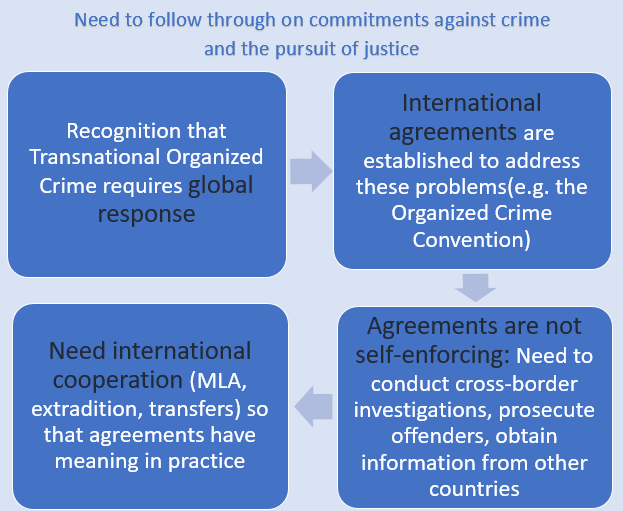Article 17 of the Organized Crime Convention deals with the transfer of sentenced persons.
|
Article 17. Transfer of Sentenced Persons States Parties may consider entering into bilateral or multilateral agreements or arrangements on the transfer to their territory of persons sentenced to imprisonment or other forms of deprivation of liberty for offences covered by this Convention, in order that they may complete their sentences there. |
This is a specific form of international cooperation in criminal matters, which addresses the return of a person sought for the enforcement of a sentence in a state of nationality or residence. It concerns only the transfer of persons who are currently serving a sentence. It is therefore a separate issue from deportation of offenders who have completed their sentences and are thus no longer subject to criminal proceedings.
Countries interested in transferring a sentenced person usually rely on bilateral or multilateral agreements with other countries. Countries are also increasingly concerned about the conditions in which the transferred prisoner will serve the sentence. This concern is demonstrated by the inclusion of provisions on prison conditions in transfer agreements.
The Seventh United Nations Congress on the Prevention of Crime and the Treatment of Offenders adopted the Model Agreement on the Transfer of Foreign Prisoners and the recommendations on the treatment of foreign prisoners in 1985. The box below includes the nine general principles that underlie the transfer of sentenced persons contained in the Model Agreement. It can be seen that the principles attempt to balance the interests of the State parties to the agreement, together with the rights of the sentenced person.
|
Model Agreement on the Transfer of Foreign Prisoners General Principles
|
|
UNODC technical assistance tools on transfer of sentenced persons In 2012, UNODC developed the Handbook on the International Transfer of Sentenced Persons in an effort to explain how transferring sentenced persons to serve their sentences in their home country can contribute to dealing with them fairly and effectively, as well as the cooperative process to facilitate their transfer. |
An important regional instrument in the field of transferring of sentenced persons is the Convention on the Transfer of Sentenced Persons (Council of Europe, 1983) and its Additional Protocol of 1997, negotiated within the context of the Council of Europe and implemented by its Member States. However, they are also open to ratification/accession to countries that are not Members of the Council of Europe.
Figure 11.1 illustrates the connections among transnational crime, international agreements, and the need for cooperative efforts for their enforcement. Countries have recognized the growth of transnational organized crime, resulting in the Organized Crime Convention, and other multilateral, regional and bilateral agreements (UNODC, 2006). But these agreements require law enforcement and judicial cooperation that results in investigations and prosecutions (Aromaa and Viljanen, 2005; Hartfield, 2008). Therefore, the implementation of the agreements is the real measure of success of international cooperation.
